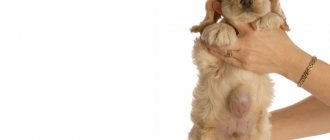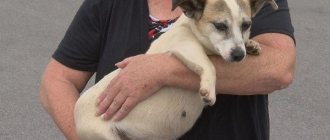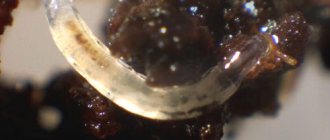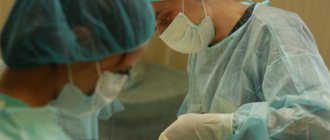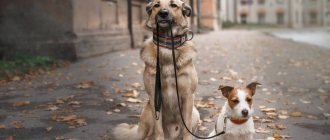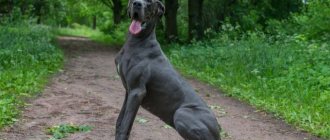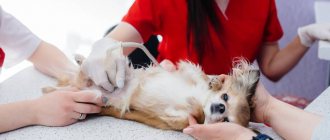Veronica Igorevna Sharipova
veterinarian Petstory
A hernia in a dog in the general sense is a protrusion of an organ or part of it under the skin between muscles, internal organs or bone structures through openings in anatomical formations. In other words, this is a local violation of the integrity of the body, manifested in a displacement of the normal anatomical location of organs relative to each other.
- Hernia removal
Most often, hernias occur in dogs; there is no gender predisposition. There are breed characteristics: for example, dachshunds suffer from intervertebral hernias more often than other dogs.
Hernia - what is it?
If an animal has a bulging formation in the abdominal area, it may be an inguinal hernia. It occurs as a result of damage to the tissues of the abdominal cavity, or rather their rupture. Because of this, the internal organs cannot be held inside and protrude through the resulting opening, called the hernial orifice. The bag can be filled with the bladder, intestines, mesentery, and uterus. The dog develops an inguinal hernia on both sides or only on one. Depending on the origin, it is divided into types: acquired and congenital.
Acquired hernia
Acquired inguinal hernia in dogs of small and large breeds is formed as a result of trauma. The latter include being hit by a car or other vehicle, strong impacts, and mechanical damage received in skirmishes with other animals. A hole in the abdominal cavity occurs due to a sharp increase in pressure in this area. It can be triggered by diseases such as frequent constipation, problems with the cardiovascular system and kidneys. An inguinal hernia can also appear after a difficult birth.
Hernia in the perineal area
A perineal hernia occurs in dogs due to weakening of the pelvic muscles. Outwardly it looks like a rounded protrusion under the tail on the side of the anus. The cause of perineal pathology can be straining of the abdominal muscles due to defecation, trauma, or congenital pathologies of the genital organs. Most often, this species is found in dogs, mainly small short-tailed breeds.
Symptoms manifest themselves as a deterioration in the dog’s condition, with lethargy, apathy, frequent constipation and urination. At the initial stage, a perineal hernia is soft and painless, does not cause discomfort and is treated with medication. Due to the progression of the disease, the swelling in the perineal area increases in size and becomes painful.
To eliminate the pathology at this stage, surgical actions are performed. After surgery, patients are prescribed a course of antibiotics, special food and diet. During the first month after surgery, loads and sudden movements are contraindicated. The pet needs peace and careful care.
Inguinal hernia in a dog: causes
Let's highlight the main reasons that can lead to the formation of an inguinal hernia. If it is congenital, then everything is very clear. And a large number of factors can provoke the occurrence of an acquired one. This pathology develops due to relaxation of the inguinal ring, as well as due to insufficient strength of the walls of the pelvic area.
Every owner should know what can cause an inguinal hernia in dogs of small and large breeds. These factors include:
- Pregnancy.
- Pathology of peritoneal tissue fusion.
- Too much physical activity.
- Bladder fullness.
- Reduction of adipose tissue in the inguinal canal.
- Accumulation of fluid in the abdominal cavity.
- Obesity.
- Weakening of muscle tone.
Treatment
An inguinal hernia can only be treated with surgery . During surgery, the veterinarian sutures the canal, that is, removes the hernia. This operation can be performed both in a veterinary clinic and at home. The main condition is disposable consumables, sterile instruments, and quartzization of the room. If an inguinal hernia due to strangulation has led to necrotization of organs or tissues, then at the first stage of the operation the dead tissue will be removed. The operation is performed under general anesthesia.
Sometimes the contents of the hernia turn out to be the pregnant uterus of a female, in which case, during the growth of the fetus, the hernia also enlarges, and during the operation the fetus is removed.
If the surgical intervention was performed in the clinic, then after the animal recovers from anesthesia, it can be immediately taken home. A dog's sutures are usually removed between the eighth and twelfth day after surgery, either at home or in the clinic.
Classification
Inguinal hernia in dogs can come in three forms. They are classified according to the condition of the bag:
- Disadvantaged. The peculiarity of this form is that the organs have already fallen into the hernial sac, but the muscle tissue of the abdominal cavity remains dense. Accordingly, this leads to their compression. The danger lies in the obstruction of normal blood circulation. The animal feels severe pain and swelling may occur. After some time, the organs lose the ability to function properly, which can lead to death. In this form, treatment is prescribed immediately.
- Reducible. It is asymptomatic. There are no painful spasms. The abdominal tissues stretch while remaining elastic. The contents of the hernial sac move unhindered. Easily adjusts when pressed or while the animal is moving. To determine the density of the bag's size and shape, a special medical diagnostic method called auscultation is used.
- Irreversible. This form has a characteristic feature - adhesive processes. The organs that fill the bag have already merged with its tissues. When you click on a formation, you can’t straighten it. Fabrics lose elasticity. An inflammatory process may develop, which subsequently develops into fibrosis.
Symptoms
Inguinal hernia in dogs has a clear clinical picture. Localized in the abdomen, in its lower part. Tends to increase. Symptoms will depend on the form in which the disease occurs. With a reducible hernia, the animal does not feel painful spasms. At the initial stage there is not even any discomfort. It will appear as the hernial sac enlarges. Body temperature rises to 42 degrees. Sometimes it is even higher. The animal also experiences increased breathing and heart rate. Due to compression of the bladder, the amount of its contents is reduced. The dog constantly feels a false urge to have a bowel movement. As the hernia enlarges, he may refuse to eat and behave restlessly. It is important to know that with an irreparable form, all these symptoms intensify. The animal feels constant pain, does not allow touching the bulging area, and may even bite the owner.
Diagnostics
It is not difficult to identify a hernia visually. If it is large, it will be visible in any position of the dog. Things are more complicated with a little one. The owner, playing with the dog, turns it on its back, while examining its stomach. If there is a lump on it, you should immediately make an appointment with a doctor. At the initial stage, it is much easier to fight the disease.
The diagnosis is made as follows:
- Make an appointment with a specialist. At the appointment, the doctor examines the animal. Performs palpation of the inguinal and abdominal cavities. Swelling will indicate that a hernia has occurred. They can be round or elongated. The doctor determines the form of the disease, the hernial orifice. You can also determine by palpation whether there is an infringement and whether the contents are being reduced.
- Examination. The animal is prescribed ultrasound diagnostics and radiography. In the first case, you can determine the contents of the bag. But radiography allows you to determine whether displacement of other abdominal organs has occurred.
With such a disease, you don’t need to rely on your own strength. The danger lies in the fact that in case of infringement it is necessary to urgently perform surgery. Even a small delay can lead to undesirable consequences. Only a qualified doctor will recognize pyometra in case of an inguinal hernia in a dog. This disease is dangerous for the animal, as pus accumulates in the uterus. The bulge on the female's belly will continually increase in size. Without treatment it will lead to sepsis. And this is a direct threat to life.
Prevention
Congenital pathologies cannot be predicted in any way. But, if the puppy is absolutely healthy, then you can follow some preventive measures to prevent a hernia from developing during life.
- The dog must be kept in favorable conditions.
- Puppies up to 10-12 months should be carried down and up stairs.
- A properly balanced diet will help avoid problems with your dog's stool.
- You should walk your dog on a leash to reduce the risk of various injuries.
- Non-breeding pets are recommended to be neutered at an early age.
- It is imperative to fully treat all past illnesses.
- If swelling is detected, it is better to immediately consult a doctor to prevent the development of an infringement.
Treatment of inguinal hernia in dogs
A hernia cannot be treated with medication. You also can’t rely on traditional medicine, no matter how much they say otherwise. In order to save your pet, you will have to agree to surgery. This is the only way.
How is an inguinal hernia removed in a dog? The surgeon makes an incision to gain access to the abdominal cavity. Through it, the contents of the sac are released, pushing the organs inside. Afterwards it is removed, and the abdominal tissues are stitched together. The last stage is applying external sutures. The operation is simple, but it must be performed under sterile conditions. They can only be provided at a veterinary clinic. Also, complications may arise during the operation, so everything you need should be at hand.
Some clinics offer to perform hernia removal at home. However, this procedure is accompanied by a high risk of complications. The fact is that the room must be treated with a quartz lamp. Also, only sterile instruments and material are used during the operation. It is quite difficult to create such conditions at home. Moreover, we must not forget that surgery is performed under general anesthesia, which can also cause complications. Not all dogs tolerate it well.
The owner does not need to leave his pet in the clinic for a long time. After the operation, as soon as the anesthesia wears off, the dog can be taken home. Be sure to follow all doctor's instructions and come for an examination in 8-12 days to have the stitches removed.
Hernia in the spine
As a result of stress on the spine, intervertebral discs become displaced. In this situation, it is important how much the spinal cord is affected. You can recognize the presence of a spinal hernia by the dog’s behavior. Slow movements, tension in the back muscles, and difficulty bending the head indicate the presence of pathology.
This type of hernia is the most dangerous, as it can lead to paralysis. If you suspect a vertebral hernia, you should contact a veterinary clinic as soon as possible. The doctor will conduct a full examination and take an x-ray of the spine. Based on the data obtained, the veterinarian prescribes therapeutic therapy. For mild cases of intervertebral disc displacement, anti-inflammatory drugs are prescribed. With an advanced form of hernia, urgent surgical intervention is necessary.
Postoperative period
If an inguinal hernia has been operated on in a dog, then it is necessary to provide it with proper care. This will determine how quickly the animal recovers. The first step is to equip him with a sleeping place. The pet should be comfortable there. The owner will need to keep the litter clean. If it is wet, then change it to dry in time. It is also important to ensure that your dog is at a comfortable temperature. It should not be very high or low. It is not allowed to equip a sleeping place in a draft.
After removal of the hernia, the animal should not be subjected to physical activity. He needs peace. The more the dog sleeps, the faster it will get stronger. For the first few days, your pet cannot be taken outside, so you will have to equip a toilet at home. It will, of course, be difficult to accustom an adult dog to it, but you will have to be patient.
In order to prevent the seams from licking, you need to wear a special collar around your neck. This will minimize the risk of wound infection. The owner needs to regularly clean post-operative sutures. To do this, use antiseptics prescribed by a veterinarian.
It is also worth reviewing your dog's diet. After surgery, you must adhere to a diet. It is compiled depending on the anesthesia and the complexity of the surgical intervention. For dogs that have been fed dry food, it is recommended to choose a special brand. It must be soaked before use. Fermented milk products are introduced into the diet of natural-fed pets. Give meat only in the form of minced meat, mixing it with porridge. You can also feed with low-fat broths. A bowl of water is placed next to the sleeping area so that the animal has constant access to it.
Important: after surgery, the dog should not be fed for several hours. It is also not allowed to give her water. If your pet's mouth is very dry, you can slightly lubricate the lips with a damp swab.
